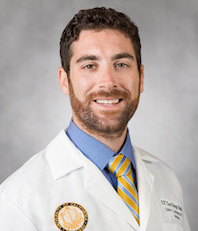Independent Interventional Radiology (IR) Fellowship
Overview
The American Board of Medical Specialties (ABMS) now recognizes Interventional Radiology (IR) as a distinct, stand-alone medical specialty, and the Accreditation Council for Graduate Medical Education (ACGME) has established program requirements for this new specialty. Our program obtained accreditation in 2017 and we offer 2 positions in the National Radiology Fellowship Matching Program (NRMP) Match. Residents who know they want to specialize in Interventional Radiology (IR) may apply to the Independent Interventional Radiology Residency Program at UCSD.
Training Program
There are two ACGME-approved positions available in our Independent Interventional Radiology Residency (IR) Program per year. The program is 1 or 2 years in length and focuses on 12 or 24 months of advanced interventional radiology training. If the resident received Early Specialization in Interventional Radiology (ESIR) certification during diagnostic radiology residency, the resident is eligible for 1 year of independent training. If the resident did not receive ESIR certification, the resident is required to complete 2 years of independent training. Graduates of the IR-Integrated Residency qualify to take the Interventional Radiology/Diagnostic Radiology examination offered by the American Board of Radiology (ABR).
During the 1 or 2 years of training in Interventional Radiology, the UC San Diego IR resident is exposed to the clinical framework within which interventional radiology is practiced. The development of clinical skills, understanding of procedural indications, pre-operative and post-operative patient management, and proper identification and handling of complications are integral components of the training. Vascular imaging is an integral part of the training program. There are ample opportunities to engage in research during the residency. In addition, residents can rotate in various clinical services such as ICU, Oncology, Vascular Surgery, Urology, Neurosurgery, Nephrology, Neurointerventional Radiology, among others. The UCSD IR Division participates in outpatient clinics, hospital admissions, and inpatient consultations as part of its clinical service.
Faculty & Hospitals
The Division of Vascular and Interventional Radiology at UC San Diego consists of 13 core, full-time interventional radiology faculty with 7 physician extenders. Additionally, there are 15 adjunct IR faculty within other divisions and at other sites.
There are 12 interventional suites located at 4 hospitals: UC San Diego Medical Center at Hillcrest, UC San Diego Medical Center La Jolla Campus (Thornton Pavilion and Jacobs Medical Center), and the VA San Diego Healthcare System. In addition, residents rotate through Kaiser Permanente San Diego and Rady Children's Hospital.
Curriculum
Residents should expect the follow rotations over the course of 1 year of training:
- Jacobs IR - 16-20 weeks
- Hillcrest IR - 8 weeks
- VA IR - 8 weeks
- Neurointerventional - 4-8 weeks
- Kaiser IR - 8 weeks
- ICU or Elective - 4 weeks
Program Directors

Quinn C. Meisinger, MD
Program Director, Interventional Radiology Integrated & Independent Residencies
Associate Professor of Interventional Radiology

Rupal Parikh, MD
Assosciate Program Director, Interventional Radiology Integrated & Independent Residencies
Assosciate Professor of Interventional Radiology
How to Apply
Resident who know they want to specialize in Interventional Radiology may apply to the UCSD Independent Interventional Radiology Residency Program. The program has no preference on geographical location of your diagnostic radiology residency. For more information check our Application Process page.
Contact us with questions about our residency and your application!

Brian Andrew, MD
Independent Chief Resident
Anti-Discrimination Policy
In accordance with applicable Federal and State law and University policy, the University of California does not discriminate, or grant preferences, on the basis of race, color, national origin, religion, sex, disability, and/or other protected categories.
